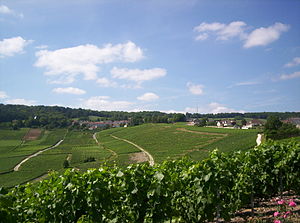Hautvillers
| Hautvillers | ||
|---|---|---|

|
|
|
| region | Grand Est | |
| Department | Marne | |
| Arrondissement | Epernay | |
| Canton | Epernay-1 | |
| Community association | Grande Vallée de la Marne | |
| Coordinates | 49 ° 5 ' N , 3 ° 57' E | |
| height | 68-274 m | |
| surface | 11.77 km 2 | |
| Residents | 695 (January 1, 2017) | |
| Population density | 59 inhabitants / km 2 | |
| Post Code | 51160 | |
| INSEE code | 51287 | |
| Website | http://www.hautvillers.fr/ | |
 View of Hautvillers |
||
Hautvillers (derived from "Altavilla" and "Altvillots") is a French commune with 695 inhabitants (as of January 1, 2017) in the Marne department in the Grand Est region , about 7 km from Épernay and 20 km from Reims . The municipality belongs to the canton Épernay-1 (until 2015: canton Ay ). It is located in the Montagne de Reims Regional Nature Park .
Saint Pierre d'Hautvillers Abbey
Around 650/662 Archbishop Nivard von Reims founded the Saint Pierre d'Hautvillers Abbey here , one of the oldest Benedictine monasteries in the world. According to legend, a dove showed him the place where he should build a monastery according to the rules of Saints Benedict and Columban . Nivard's successor as Archbishop of Reims, Rieul , began his ecclesiastical career in 669 in Hautvillers. In the 9th century the monastery was an important scriptorium and center of book illumination . B. the Ebo Gospels and the Utrecht Psalter come from. It also gained a reputation as an excellent wine producer.
The monk Gottschalk von Orbais († 869), persecuted relentlessly by Rabanus Maurus and Hinkmar von Reims for his radical conception of the so-called "gemina praedestinatio" - the double predestination (predestination) of God, spent the last twenty years of his life in Hautvillers .
The monastery was devastated by Normans in 882 , burned down by the English in 1449, destroyed by the Huguenots in 1564 during the Huguenot Wars , and yet repeatedly restored, most recently with the financial support of the French Queen Catherine de Medici .
Birthplace of champagne
In 1668 the monk Pierre Pérignon, called Dom Pérignon (around 1638–1715), came from a monastery near Verdun to Saint Pierre d'Hautvillers and was there until his death Cellerar , the brother responsible for the economic supply of the monastery. Since the wine production was one of the main sources of income of the monastery, this came under his supervision and he became de facto cellar master . He was the first to froth ( mousse ) the champagne wine , investigated the phenomenon of double fermentation and was the first to blend wines from different locations into a cuvée . He played a key role in developing the “ Méthode champenoise ”, a bottle fermentation process for the production of sparkling wine , but according to the prevailing opinion today, he did not invent it. The technique of white pressing red grape varieties can be traced back to him.
Moët & Chandon winery
After the French Revolution , many goods that had initially been confiscated were sold to bring money into the empty state coffers. These included the former Hautvillers Abbey, which was bought in 1794 with the surrounding vineyards by Jean-Remy Moët, who turned it into a winery that is still owned by the company, which was renamed Moët & Chandon in 1832 . Since 1921 she has named her most famous champagne after the cellar master from the 17th century. Previously, local winemakers had been using the name for their wines since the early 19th century. There is a wine museum in the winery.
Population development
| year | 1962 | 1968 | 1975 | 1982 | 1990 | 1999 | 2007 | 2014 |
|---|---|---|---|---|---|---|---|---|
| Residents | 795 | 824 | 758 | 810 | 864 | 849 | 800 | 760 |
| Source: Cassini and INSEE | ||||||||
Attractions
Abbey church
All that remains of the former monastery is the Saint-Sidulphe abbey church, renovated in the 17th century, with its 17th and 18th century monks' choir, interesting paneling, choir stalls and paintings, including two works from the workshop of Philippe de Champaigne . A mighty chandelier made from the four wheels of a wine press hangs above the main altar . In the church there is the tombstone of Dom Perignons.
Wrought iron figureheads
Buildings
- 245 meter high transmission mast for broadcasting VHF radio and television programs
Town twinning
- Hautvillers has been the partner community of Kiedrich in the Rheingau-Taunus district in Hesse since 1981 .
Personalities
- Almannus von Hautvillers (around 830-889), hagiograph
- Adolphe-Napoléon Didron (born March 13, 1806 in Hautvillers, † November 13, 1867 in Paris), archaeologist
literature
- François Morel: The Most Beautiful Wine Villages of France. Mitchell Beazley, London 2005, ISBN 1-84533-143-5 , pp. 12-13.
- Lawrence Nees: On Carolingian book painters: The Ottoboni Gospels and its Transfiguration Master. In: The Art Bulletin. Vol. 83, No. 2, 2001, pp. 209-239, doi : 10.1080 / 00043079.2001.10786979 .
Individual evidence
- ^ Heinzelmann, Martin: Almannus von Hautvillers, Hagiograph (around 830-889). In: Lexikon des Mittelalters Tl. 1 S. Sp. 445–446. 1980, accessed August 6, 2018 .
- ↑ Andrea Binsfeld: Helena - Roman Empress (around 250 - around 328 AD). In: Portal Rhenish History. LVR, accessed August 6, 2018 .




